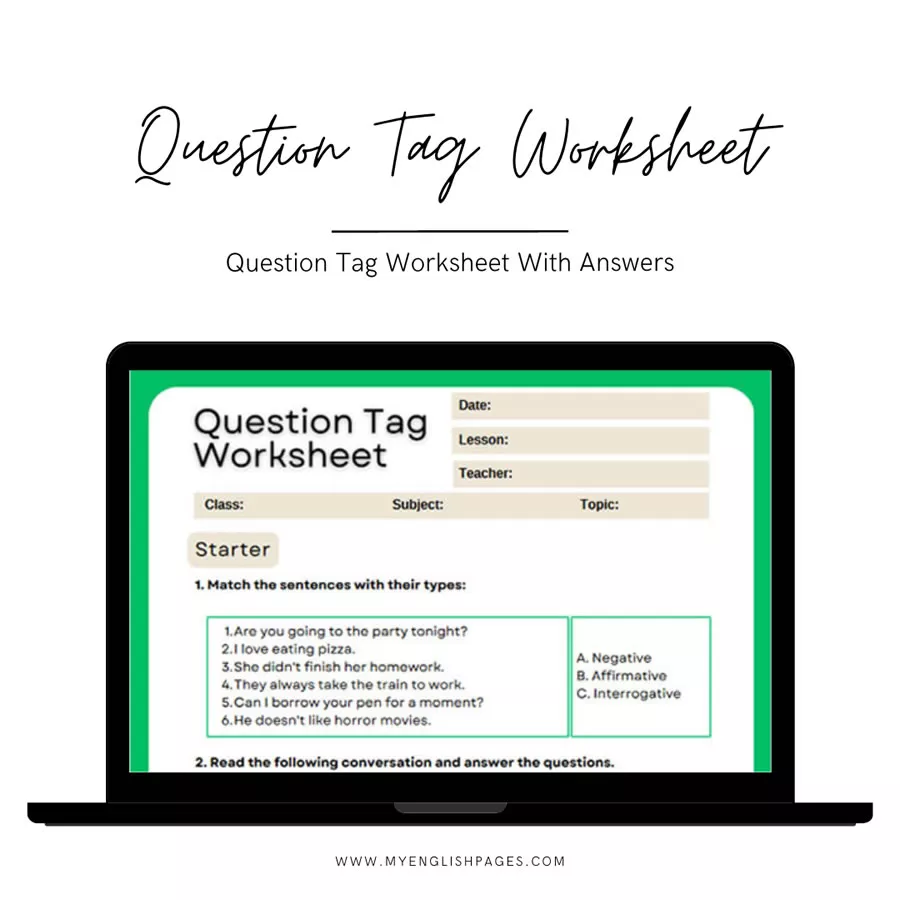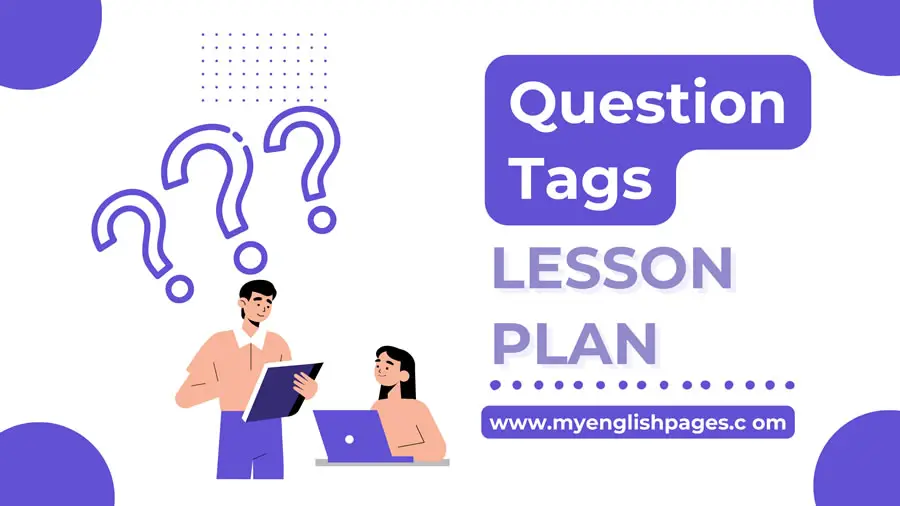Table of Contents
Question tags
The aim of this question tags lesson plan is to help your students develop their understanding of the form and use of question tags in English. The activity includes:
- Eliciting students’ awareness of the use of question tags,
- Sentence matching and gap-filling exercises
- Followed by an active practice of question tag forms.

Question Tag Worksheet
Are you interested in a question tag worksheet with answers?
Check this workshop in our digital products store!
- Designed for intermediate-level learners, this worksheet uses a discovery-based approach to help students fully understand the form and use of question tags.
- With materials needed as simple as pen and paper, this worksheet can be completed in just one class period.
- The objectives of the worksheet include reviewing different sentence types, improving comprehension skills, identifying and categorizing different types of questions, and practicing the form and use of question tags.

Question tags lesson plan
This lesson plan focuses on teaching auxiliary verbs and question tags to intermediate-level students. The lesson aims to activate students’ knowledge about the use of auxiliary verbs, introduce the concept of question tags, and provide them with practice using question tags in conversation. This lesson plan includes various exercises such as matching, gap filling, and active practice of question tags.
Objectives:
- Activate students’ knowledge about the use of auxiliary verbs
- Introduce the concept of question tags
- Provide students with practice using question tags in conversation
Level: Intermediate
Timing: Approximately 60 minutes
Materials needed:
- Board
- Markers
- Handouts for matching and gap-filling exercises.
1. Auxiliary Verbs
Divide the class into small groups. Start with a yes/no questions exercise to activate students’ knowledge about the right use of the auxiliary verbs.
Example:
- Do you like soccer? – Yes, I do.
- Have you got any brothers or sisters? – No, I haven’t.
- Are you good at mathematics?
- Did you watch TV yesterday?
- Can you speak Chinese?
2. Introducing Question Tags
Introduce question tags by writing model examples on the board.
Examples:
- You are French, aren’t you?
- You like jogging in the morning, don’t you?
- You don’t like jogging in the afternoon, do you?
- You went to the gym yesterday, didn’t you?
- He didn’t go to a restaurant, did he?
- ….
Students discuss the different examples of question tags and notice how they are formed. They also should be able to see that question tags are mainly used to keep a conversation going, or confirm information, and that using question tags necessitates a keen understanding of the use of various auxiliary verbs.
3. Matching Exercise
Students match question tags:
| You are mad about playing chess,… | …isn’t it? |
| He isn’t working now,… | …had he? |
| They won’t visit New York,…. | …does it? |
| He hasn’t done his job,… | …are they? |
| She found a necklace,… | …don’t they |
| She isn’t an honest girl,… | …won’t they? |
| They do an excellent job,… | …is she? |
| It doesn’t matter,… | …didn’t she? |
| They’ll fail,… | …has he? |
| They are coming,… | …will they? |
| He hadn’t read the book before,… | …is he? |
| This is amazing,… | …aren’t you? |
4. Gap Filling
Students then do the exercise below to enhance the use of the tag question. This time, they have to complete the tag questions
- You didn’t visit the museum, ________
- He’s happy to make the trip, __________
- They’ll meet at the airport on Sunday, _________
- She’s single, __________
- You wrote that poem, _________
- You love singing, ___________
- She doesn’t speak English well, ________
- He hadn’t lived there before, ________
- They have done a good job, __________
5. Active Practice of Question Tags
Ask each student to write information about themselves in the form of simple statements answering questions like:
- What’s your name?
- Where do you come from?
- What did you do yesterday evening?
- …
Collect the statements and redistribute the sheets to different students. Each student then uses the statements to form question tags, addressing the question to the student who has written the statements.
Example:
- Your name is Alan, isn’t it?
- You come from Spain, don’t you?
- You aren’t French, are you?
- …
Conclusion
This question tags lesson plan provides an effective approach to teaching auxiliary verbs and question tags to intermediate-level students. By activating students’ prior knowledge, introducing the concept of question tags, and providing ample practice opportunities, students will be better equipped to use question tags correctly and confidently in conversation. Try incorporating this lesson plan into your classroom instruction. It will undoubtedly help students improve their English language skills.
If you need a more detailed worksheet to teach question tags, check out this digital product on our online store:



